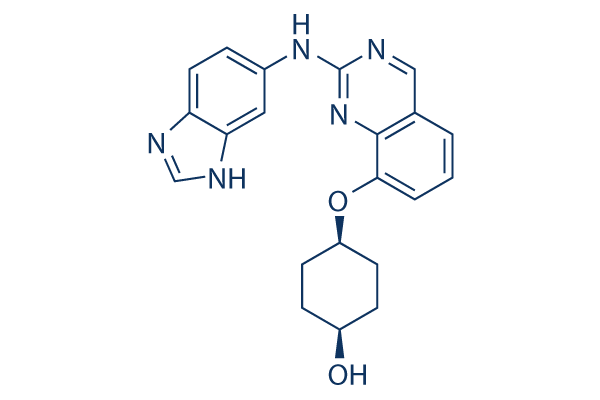All AbMole products are for research use only, cannot be used for human consumption.

In vitro: NCB-0846 blocks Wnt signalling and shows marked anti-tumour and anti-CSC activities. NCB-0846 binds to TNIK in an inactive conformation, and this binding mode seems to be essential for Wnt inhibition. NCB-0846 shows inhibitory activity against TNIK with an half-maximal inhibitory concentration (IC50) value of 21 nM. It also inhibits FLT3, JAK3, PDGFRα, TRKA, CDK2/CycA2, and HGK (>80% at 0.1 μM). NCB-0846 induces faster migration of TCF4 phosphorylated by TNIK within a concentration range of 0.1-0.3 μM and completely inhibits the phosphorylation of TCF4 at a concentration of 3 μM. Furthermore, NCB-0846 blocks the auto-phosphorylation of TNIK. NCB-0846 inhibits the TCF/LEF transcriptional activity of Wnt3a-treated HEK293 and HCT116 (carrying CTNNB1 mutation) and DLD-1 (carrying APC mutation) colorectal cancer cells. NCB-0846 reduces the expression of the Wnt target genes AXIN2 and MYC as well as that of TNIK, but the expression of CCND1 is not affected. NCB-0846 also reduces the expression of TNIK, AXIN2 and cMYC at the protein level. LRP6 and LRP5 are also downregulated by NCB-0846. NCB-0846 can inhibit cancer cell growth in vitro. NCB-0846 induces an increase in the sub-G1 cell population. NCB-0846 can downregulate the expression of putative colorectal CSC markers: CD44, CD133, and aldehyde dehydrogenase-1 (ALDH1), and reduce the proportion of cells showing high expression of CSC surface markers (CD44, CD133, CD166, CD29 and EpCAM). NCB-0846 also reduces the expression of mesenchymal markers (Slug, Snail, Twist, Smad2 and Vimentin). However, embryonal stem cell markers (Oct4, Nanog and Sox2) are not affected.
In vivo: NCB-0846 suppresses Wnt-driven intestinal tumorigenesis in Apcmin/+ mice and the sphere- and tumour-forming activities of colorectal cancer cells. The body weight of mice (immunodeficient tumor xenografts) falls at the beginning of NCB-0846 administration, but gradually recover. The expression of Wnt-target genes (AXIN2, MYC and CCND1) in xenografts is reduced following the administration of NCB-0846. NCB-0846 dose dependently reduces the multiplicity and dimensions of tumours that developed in the small intestine. NCB-0846 significantly suppresses the growth of the PDXs (patient-derived xenografts) established from the two patients in two more clinically relevant mouse models.
| Cell Experiment | |
|---|---|
| Cell lines | HCT116 cells |
| Preparation method | HCT116 cells are cultured in the presence of DMSO (vehicle), 1 μM NCB-0846, or 1 μM NCB-0970 for 4 or 24 h and then analysed by immunoblotting with anti-phosphorylated TNIK, anti-TNIK, and anti-γ-tubulin (loading control) antibodies. |
| Concentrations | 1 μM |
| Incubation time | 4 or 24 h |
| Animal Experiment | |
|---|---|
| Animal models | Immunodeficient mice (background-BALB/c nude mice) |
| Formulation | DMSO/polyethylene glycol#400/30% 2-hydroxypropyl-β-cyclodextrin solution (10:45:45, v/v) |
| Dosages | 40 or 80 mg/kg BID |
| Administration | by oral gavage |
| Molecular Weight | 375.42 |
| Formula | C21H21N5O2 |
| CAS Number | 1792999-26-8 |
| Solubility (25°C) | DMSO 30 mg/mL |
| Storage |
Powder -20°C 3 years ; 4°C 2 years In solvent -80°C 6 months ; -20°C 1 month |
[1] Yamada T, et al. Cancer Sci. Emergence of TNIK inhibitors in cancer therapeutics.
[2] Masuda M, et al. Nat Commun. TNIK inhibition abrogates colorectal cancer stemness.
| Related TNIK Products |
|---|
| TNIK-IN-3
TNIK-IN-3 is a potent, selective and orally active TNIK inhibitor with an IC50 value of 0.026 μM. In addition, TNIK-IN-3 inhibits Flt4 (IC50=0.030 μM), Flt1 (IC50=0.191 μM) and DRAK1 (IC50=0.411 μM). -3 can be used in studies related to colorectal cancer. |
| PF-794
PF-794 (PF-06279794) is a potent, selective, ATP-competitive TNIK inhibitor. |
| Jatrorrhizine
Jatrorrhizine, an isoquinoline alkaloid found in common medicinal plants, is also a TNIK inhibitor with antibacterial, anti-inflammatory and antitumor activities. |
| Mebendazole
Mebendazole is a highly effective, broad-spectrum antihelmintic indicated for the treatment of nematode infestations; has been found as a hedgehog inhibitor. |
All AbMole products are for research use only, cannot be used for human consumption or veterinary use. We do not provide products or services to individuals. Please comply with the intended use and do not use AbMole products for any other purpose.


Products are for research use only. Not for human use. We do not sell to patients.
© Copyright 2010-2024 AbMole BioScience. All Rights Reserved.
